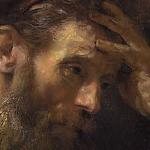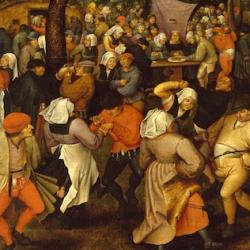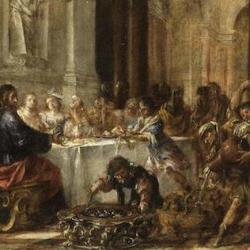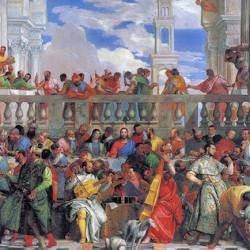Mary appears twice in John’s Gospel. She is at the wedding of Cana, where Jesus does His first sign and first reveals His glory. She reappears at the foot of the cross (John 19), at the hour of Jesus.
As Max Thurian points out (Mary, Mother of All Christians), Jesus’ words to her and the beloved disciple are the climactic words of the hour, after which Jesus drinks vinegar, cries that it is finished, and passed on HIs Spirit. Once he has spoken to His mother and the Beloved Disciple, “from this moment all was accomplished.”
Thurian rejects the popular idea that Jesus is providing for his mother’s care after his death: “If the words of Christ have only a charitable import, one must ask why Christ waits until the moment before His death before providing for His mother’s future.”
Besides, if Jesus were merely concerned for Mary’s future, he would not need to commend the disciple to her care. If he were concerned only with her as His mother, why address her as “Woman”? Filial devotion isn’t absent; Mary goes to live with the Beloved Disciple. But it’s not a sufficient explanation.
We can grasp the role of Mary only when we see that the events at the Cross are concerned with the “fulfilment of the Messianic mission of the Lamb.” Jesus’ words to Mary and the disciple are part of that fulfillment.
At the foot of the cross, Mary is a type of the church: “As a type of the Church, Mary intimately shares in the suffering of the Crucified; and this suffering of the Daughter of Zion, who gives birth to her hope in the resurrection, and in the birth of the new people, the Church, is also experienced by her in her human and motherly flesh. The Church can only be given birth at the foot of the Cross, by the power of the spirit transmitted by the Crucified, if the faithful remnant of the messianic community believe in the face of all the evidence, and hope against all hope: ‘From his side there will flow rivers of living water.’”
By the same toke, the Beloved Disciple is a true son of the church, of which Mary is a type: “By faith she is completely the Daughter of Zion who gives birth to hope even in grief, the Church believing and faithful even to the end. By faith in the Crucified who will rise again, in her grief as a mother and as a believer, she is truly the type of the Mother Church of the faithful. It is as such that Jesus regards her and speaks to her: ‘Woman, behold thy son.’ The beloved and faithful disciple is the true son of the Church of which Mary is the type in the sharing of the suffering of the Crucified, in her faith and in her hope in the Resurrection.”
“the Gospel writer wishes to emphasize thus the symbolic character of Mary, mother of Jesus, who is finally called ‘the mother,’ as if this title was her own new name. It is just the same for ‘the disciple’ At the foot of the Cross, when the Hour has come, to which Jesus had directed His mother’s attention after the marriage at Cana, ‘the mother of Jesus’ becomes ‘the Mother/ the type of Mother Church,’ and ‘the disciple whom Jesus loved’ becomes ‘the disciple/ the type of the faithful in the Church.’ In the Gospel of St. John, neither ‘the mother’ nor ‘the disciple’ bear their proper names of Mary and John; they are described by their vocations, they are persons who have been set by their calling in the history of salvation on a symbolic and mystical level: they are ‘types’/ ‘icons’ of Mother Church and of the faithful brethren of Jesus. The Gospel writer is not interested in their individual history, but in their personal calling, and their theological setting in the Gospel, or in their symbolic function vis-a-vis the Church and their mystical relationship with Christ and His messianic work.”
Speaking to Mary as “woman,” He speaks to the church “who shares in His suffering, who believes, hopes, loves and who is entrusted by Jesus with the beloved and faithful disciple, who symbolises all the faithful, the beloved brethren of Christ, indeed all His brethren”
This symbolic-theological understanding of the incident explain why “Jesus commits her to the beloved disciple and him to her. The period of Mary’s human motherhood in regard to the Son of God incarnate, the fulfilment of which Christ had already declared at Cana, here finds its completion: she, the Mother of God, becomes the type of Mother Church. Henceforth it will not be possible to speak of the Church, of her humility, motherliness, her faith or her joy … without conceiving of Mary, the Mother of the Lord, as her pure expression, her archetype, and as her first realization. ‘Maria-Ecclesia: Ecclesia-Maria.’ ”
In short, “On Calvary, as we have seen, scripture is fulfilled and all the types of the Old Testament: the Paschal Lamb, the King, the High Priest, all have Christ as their fulfilment. In Mary is fulfilled the transition from the old to the new Israel, since Jesus as He dies ‘gives up the Ghost’ to her and to him who represent the Church, in both her motherhood and her faithfulness.”
Thurian observes that the mother-son statement on the cross recalls the Davidic covenant formula: The disciples becomes son to Mary and Mary mother to the disciples as Yahweh as Father to David’s son and David’s son as Yahweh’s.
Jesus’ words thus highlight the new order that is coming into being with the fulfillment that happens in His hour: “The New Covenant was established between the Father and the beloved disciples, Christ’s brethren, by the motherhood of the Church, the ‘Jerusalem from on high which is free, our mother’ (Gal. 4: 26). The Church, symbolized by Mary, receives at the foot of the Cross this maternal mission in the presence of Christ’s brethren, the children of the Father; thus the New Covenant is expressed in family terms: the people of God becomes the family of the Father, with the Church in the Holy Spirit as mother and the Son as the first-born brother of the beloved and faithful disciples.”
The cross thus brings the whole new covenant order into being: “By the death of Christ and in the sorrows of this childbearing of the Daughter of Zion, in which the messianic community, represented at the foot of the Cross by Jesus’ mother and His beloved disciple, has shared, the people of the New Covenant is born; the Crucified has transmitted to them the Spirit and, from the side of the Pierced One, there have appeared the sacramental signs of water and blood, of Baptism and Eucharist; this new people is consecrated as the family of the Father; the Church in the Spirit is from then onwards the Mother of the faithful, and the disciples are the brethren of Jesus.”
Thus Jesus’ words on the cross bring to completion the progress in Mary’s standing that began at the wedding at Cana: “The Hour announced by Christ to Mary, at the marriage at Cana, has now arrived. If Jesus, at Cana, pointed Mary to the Hour of the Cross, it was in order that at this decisive moment she might understand His new vocation, matured in the course of the life of her son on earth: after the title and role of ‘Mother of God,’ she now receives the title and role of ‘the type of Mother Church.’ We understand the motherhood of the Church as we meditate on the motherhood of Mary, the mother of the Lord and the mother of the blessed disciple.”












